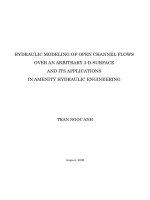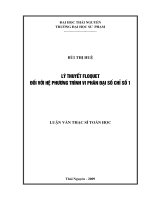Fluorine Flo
Bạn đang xem bản rút gọn của tài liệu. Xem và tải ngay bản đầy đủ của tài liệu tại đây (753.78 KB, 6 trang )
<span class='text_page_counter'>(1)</span><div class='page_container' data-page=1>
FLUORINE
<b>F</b>
By: Huy Nguyen(
Name: Fluorine Symbol: F
Type: Halogen Atomic weight:
</div>
<span class='text_page_counter'>(2)</span><div class='page_container' data-page=2>
<b>HISTORY</b>
Fluorine was discovered by Karl Scheele in 1771.
He won the 1906 Nobel Prize
in Chemistry for his work in
isolating Fluorine from its
compounds.
Fluorine was isolated in 1886 by
a French chemist Henri Moissan
</div>
<span class='text_page_counter'>(3)</span><div class='page_container' data-page=3>
<b>PROPERTIES</b>
Fluorine is a pale yellow gas with a density of 1.695
grams per liter.
</div>
<span class='text_page_counter'>(4)</span><div class='page_container' data-page=4>
Fluorine is the most reactive element. It combines easily
with every other elements except helium, neon, and argon.
Fluorine is never found in ‘free form’.
The most common fluorine minerals are fluorspar (CaF<sub>2</sub>),
<b>apatite [Ca</b><sub>5</sub>(F,Cl,OH)(PO<sub>4</sub>)<sub>3</sub>] and cryolite (Na<sub>3</sub>AlF<sub>6</sub>).
</div>
<span class='text_page_counter'>(5)</span><div class='page_container' data-page=5>
<b>Fluorspar</b>
<b>Apatite</b>
</div>
<span class='text_page_counter'>(6)</span><div class='page_container' data-page=6>
<b>USE</b>
Fluorine and its compounds have many uses:
• <sub>Toothpaste</sub>
• <sub>Rocket fuel</sub>
</div>
<!--links-->









